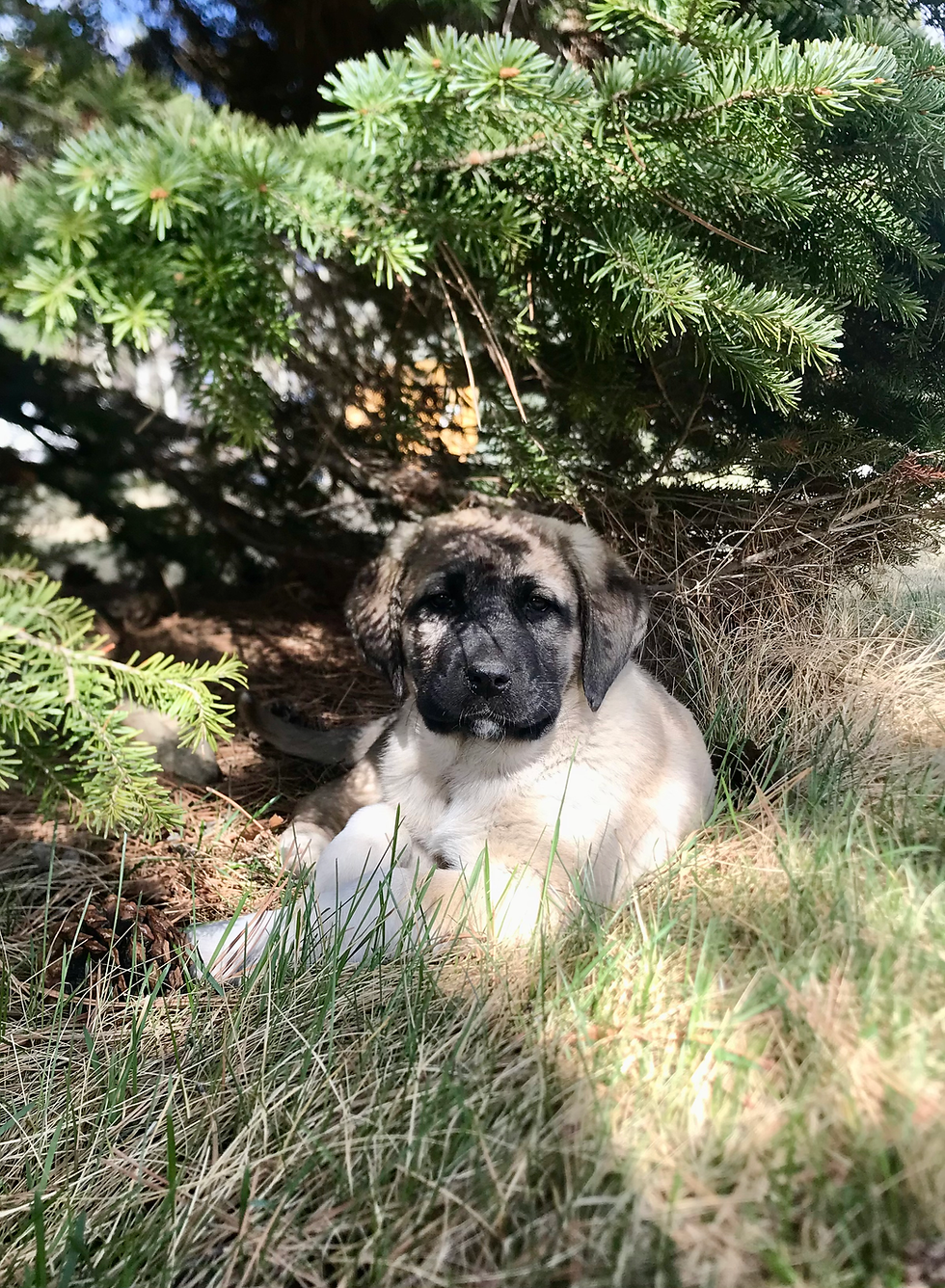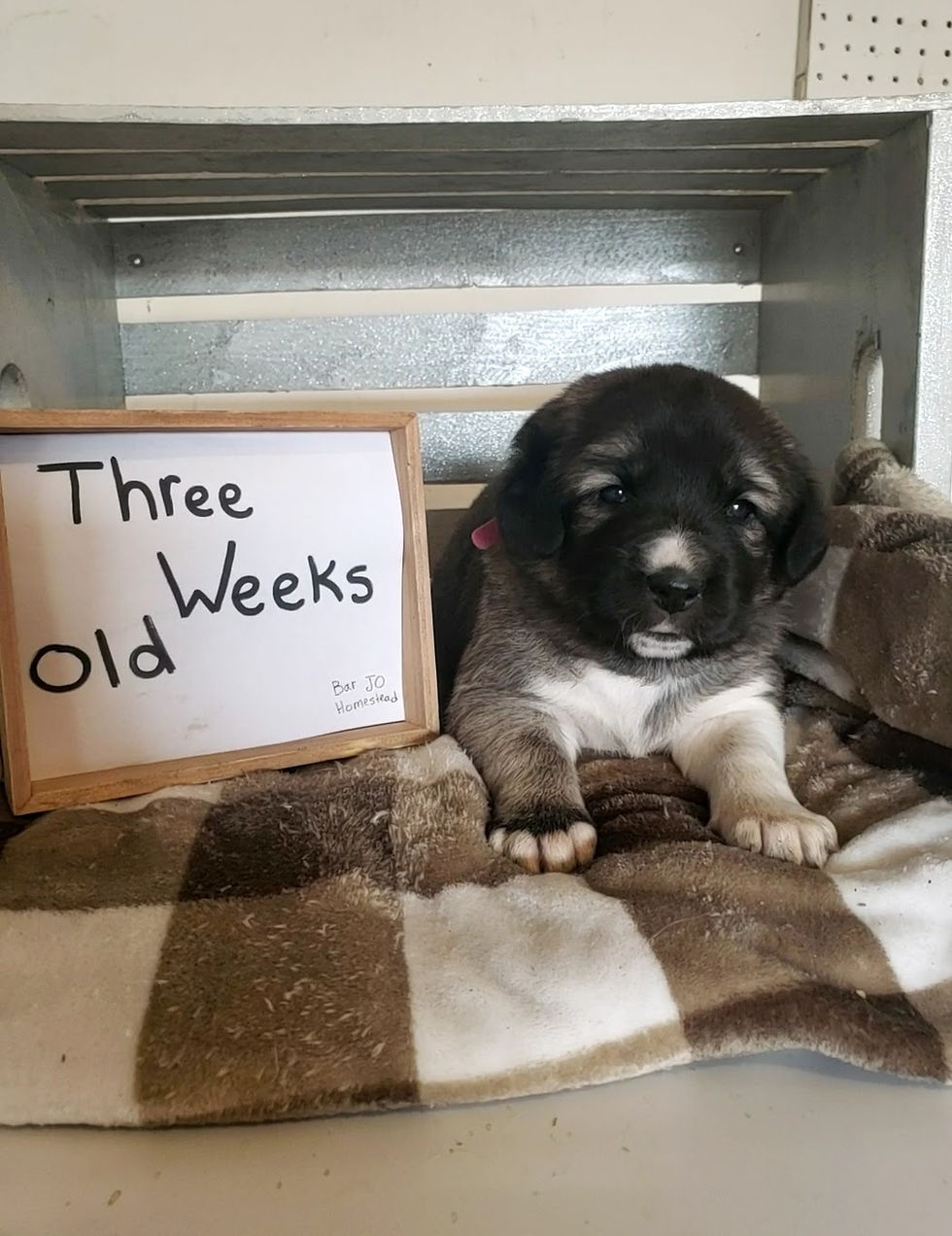Tips for Anatolian-Owners
- barjohomestead

- Jul 5
- 9 min read
We’ve been raising and training Anatolians since 2016. As you can imagine, we’ve made many mistakes along the way, but we've also discovered a few things that have transformed how we train and manage them. In this article, we want to share our nine biggest tips.
Note: As you may notice, unlike our other articles, we did no research on this. All the information is strictly based on our experience. Also, we will make several mentions of our first Anatolian, Clyde. We made many training mistakes but learned many valuable lessons for years to come and would like to share those experiences with you.

Set Expectations & Boundaries from Day 1
One of the biggest mistakes we made with Clyde was changing our boundaries and expectations for Clyde a couple of months into bringing him home. When we first purchased Clyde, we expected him to become a yard dog for our growing family. So we went about training him to the boundaries within our yard, allowing him to sleep inside of our garage and play out in the yard with the kids. However, after we owned Clyde for a couple of months we decided we wanted to add sheep to our homestead and to keep him out with the sheep from that day forward. Although Clyde had been raised with sheep before we picked him up, he had bonded closely to our family and the sheep didn’t appeal to him nearly as much. He was often discontent with the limits of the pasture and much preferred the yard. Even when he did behave himself and was within the limits of the pen, he never much cared for the sheep or any of the livestock. He preferred to keep his distance from them and observe and patrol. With our 2nd Anatolian, we kept her in with the livestock from day 1 and kept consistent expectations and boundaries from that day forward. She adjusted much better and loved the livestock much more than Clyde did, she was more content to stay in the pasture- as that is all that she had ever known.
Don’t Neglect Obedience Training
We can’t stress enough how helpful obedience training is with this breed. By nature, Anatolians are independent and stubborn, in other words, they don’t need any direction from humans to thrive. This is lovely in many circumstances until we need the dog to cooperate. With our first 2 Anatolians, we didn’t value having them know obedience commands. Nor did we value their prompt response to it every single time we asked. This lack of training on our end ended up being frustrating when we needed them to respond quickly and they didn’t. With our 3rd and 4th Anatolians, we took them to a training academy to learn how to effectively train. Thanks to the bit of time and money we took a few years back, we are now able to apply that knowledge to all of our dogs. We start training as early as 8 weeks and spend 15 minutes daily until the puppy. Once the puppy has grasped all the concepts really well, we train in a more casual day-to-day style, using each command everyday while doing chores.
It is Easier to Prevent Rather Than Correct
This one can be challenging at times but truly goes a long way. We weren’t prepared with our first Anatolian. It was my second dog (my first was a Yorkie) and my husband's first dog. We didn’t see a lot of problems until they were in action. The biggest one of these was containment. We had no clue how to contain an Anatolian when we purchased Clyde. At first, we had no fence whatsoever. As you can imagine, we quickly figured out that doesn’t work. Eventually, we did put him in a pen, but now looking back our fence was setting Clyde up for failure. We had 3 types of fencing at the time. The first one was a wood plank fence- this one actually worked, but the problem was it only made up for 1 of the 4 sides of the pen. The second type of fencing was barbed wire and the 3rd was a 3-foot chain link. These didn’t work at all. Clyde quickly learned that he could crawl under the barbed wire or jump off the chain link- since it was so short. We did eventually replace the fence with the fence we use now. This contains all of our Anatolians well. But at that point, Clyde was already over a year old and had learned to disrespect fencing. No matter what pen we put him in, he didn’t respect it and escaped. I am 99% certain this could have all been prevented if we had just had proper fencing to begin with. If we had just prevented the problem before it became a problem. While we’re on the topic of fencing, some people will argue that dogs are escape artists due to genetics. We disagree with this. Our neutered LGD Hunter is Clyde’s son and is easy to contain. We’re pretty sure that it is because we prevented the problem before it existed.
Always Be Consistent & Firm
This is a simple thing that Anatolian owners can apply daily that will make a big impact. Similarly to tip number 1, it holds owners to be consistent with our expectations and firm with the boundaries set. Anatolians are instinctively stubborn and independent. They need consistent and firm handling to yield wanted respect and responses. When Clyde escaped the pen to be with us, we didn’t reward this behaviour. We gave him no attention and put him right back in his pen. When we give a voice command to our dogs, we expect quick and willing responses. Set expectations such as they must be invited out of the pen with a leash or voice/hand commands, don’t allow them to decide which gates they’re allowed out of. This can also apply to obedience commands. We thought through what words and hand signals we would use (i.e. don’t say “lay” sometimes and “down” the next when we wanted our dog to lay down. Instead we picked 1 word “lay” or “down” and stick to it). Be consistent with punishing bad behaviour with a firm consequence. Likewise, be consistent with rewarding good behaviour also.
Know That 6-18 Months Are the Hardest
This is a difficult timeline for Anatolian owners. We’ve been raising Anatolians since 2016 and have trained over half a dozen Anatolians. Although some were harder than others, every single one of our Anatolians has been challenging at some point during this stage. We see multiple ads each year of owners rehoming their 6-18-month Anatolian. More times than not, because they have become “untrainable”, annoying, “dangerous”, etc. But really this stems from the dog becoming bigger (some of our pups are over 80 lbs at only 6 months), causing owners to indubitably expect more. However, the Anatolians' mental state isn't nearly as mature as their physical appearance. They may already be bigger than the average dog, but mentally they’re still only a pup. This behaviour might show itself in the form of chasing livestock for example. At 8 weeks, this behaviour would seem harmless and in some cases even cute, but now the pup has gained several inches and pounds and the same behaviour is dangerous and irritating. This is why expectations, boundaries, and consistent and firm training must take place before the puppy enters this stage. Prevention of anticipated behaviours should also be utilized (i.e. putting the puppy on a zip line (explained in the following tip;) when we anticipate the puppy might start wanting to chase livestock). My biggest advice is to never give up. Yes, this is a challenging stage and owners might want to throw in the towel some days. But your Anatolian is growing into the amazing guardian that they will become. Use this season to grow in training abilities and to out-stubborn your dog lol:). But by staying consistent, firm and persistent owners have an amazing guardian that they can trust and couldn’t imagine life without.
Use Zip Lines to Enforce Boundaries
Zip lines have been a game changer when it comes to correcting and preventing various behaviours. We actually learned about this from our breeder (Shepherds Rest Anatolians) back in 2020 and have used it with almost every dog we’ve trained since. If you aren’t sure what a zip line for a dog is, it's basically where a strong rope is secured to 2 high points, so it hangs off the ground by a few feet. Next, a leash or small chain is attached to the rope, allowing the leash/chain to slide across the rope. When the Anatolian is connected to the leash/chain, it allows the dog to travel up and down the pen and slightly off to either side. This allows the dog to be around the livestock but restricts access to the whole pen, so the livestock can escape out of the dog’s reach if necessary. It does work better in smaller pens because the dog can get used to being close to the livestock. We have also used it to prevent wandering. If a pen is being upgraded, we will often substitute it with a zip line until it is complete. This again allows the dog access to lots of pens while keeping them contained within their limits. Similarly, others will use it when they want to spend time with their dog in the yard but don’t want them to run off if they get distracted.
Be an Excellent Leader for Your Anatolian
By nature, Anatolians are bold, stubborn, confident, independent, and leaders. In most cases, these are essential characteristics for a guardian dog. A guardian that can go off on its own judgment and confidence to protect its flock or family. It would be irritating if owners had to tell their guardians exactly what they wanted them to do and give them the confidence to do it. However, this bold personality can sometimes be a challenge for owners. We have found that over the years being a great leader for your Anatolian is the key to respect. This doesn’t mean that you are mean and dominating, but it does require confidence and firm requests. Owners need to install from day 1 that their dog must listen to them whenever they give a command. This is why obedience training is so important. It requires us to apply many of the training methods we’ve just shared and be confident while we are applying them. When we give our dogs obedience commands, we say them sternly and follow through to ensure the dog has completed it to the best of their ability. We avoided allowing ourselves into a position where the dogs are dominant over us. This was especially important while handling intact males or natural alphas. Our Anatolians are expected to listen and submit to all of our household- even our littles! Everyone must be able to walk the dog on the leash and have the dog sit. Gaining your Anatolian’s respect is a simple thing to keep in mind daily that will yield a healthy relationship with your dog.
Train Your Anatolian for Town Too
Another mistake we made with our first 2 Anatolians was not preparing them for town. It never really crossed our minds that at some point, our dogs will have to venture into a town and the dog needs to know how to act in public. There are 4 things we do to prepare our dogs for town, The first is practicing getting in and out of vehicles. We noticed that loading our Anatolians up in vehicles and taking them somewhere fun- especially before 6 months- helps in the future. Our first couple of Anatolians refused to load into vehicles, so we had to transport them with the stock trailer, which was a big hassle. Second, we practice walking on the leash a lot. Anatolians grow very quickly and before you know it, it’ll be much more challenging to lead them. Teaching leash skills from as early as 8 weeks on can prevent pulling and poor leash manners later on. Next, we practice entering and behaving in buildings. Our Anatolians are outside with the livestock and quickly become uncomfortable with indoor areas. Lack of training in buildings has resulted in many irritating times with trying to get our dogs to enter vet clinics or training facilities. We try our best to have our dogs get used to entering houses, garages, and shops, or even taking them to the vet “for fun” to have them practice going in. This has been a game changer for when we’re in a pinch and need our dog to enter the building easily. Lastly, we train our dogs to be polite with people. We invite families over and teach our dogs to behave, by not jumping up on people- especially kids- and giving them space if necessary. Even though it may not seem obvious from day-to-day life, preparing your dog for the city is important too.
Find a Good Breeder Who Will Support You
My final tip is to take the extra time to find a good breeder, who understands the breed and is eager to be supportive if ever needed. (We have purchased from several breeders and noticed that breeders who are more involved and eager to help us have reflected in our dogs). Not only did the puppy come from better-behaved parents, but we were able to use advice the breeder recommended. More times than not, applying it to our own training has resulted in quicker and better outcomes. In some circumstances, we were completely lost and our breeder’s advice helped us overcome our struggles. Furthermore, it helped us train future dogs. We found that breeders, who truly know the breed and want the best for it, will take the dogs they chose to breed more seriously resulting in higher-quality and better-tempered puppies.
In closing, we hope at least 1 of these tips can help you along your journey with Anatolians. For further reading on some of these topics, please check out our other blogs below.



Comments